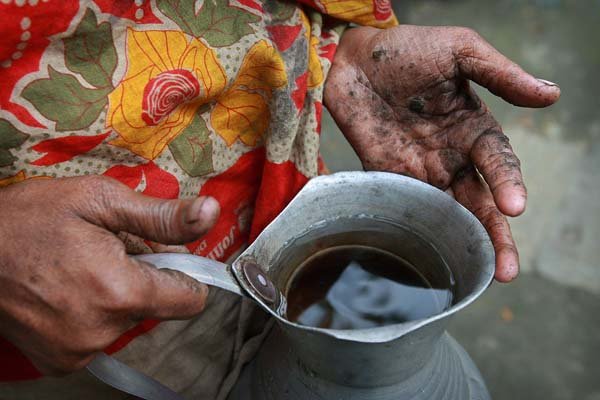CHANDIPUR, Bangladesh — Hanufa Bibi stoops in a worn sari and mismatched flip-flops to work the hand pump on her backyard well. Spurts of clear water wash grains of rice from her hands, but she can never get them clean.
Thick black warts tattoo her palms and fingers, the result of drinking arsenic-laced well water for years. It’s a legacy that new research has linked to one in five deaths among those exposed in Bangladesh - an impoverished country where up to half of its 150 million people have guzzled tainted groundwater.
The World Health Organization has called it “the largest mass poisoning of a population in history,” as countless wells continue to be dug here daily without testing the water for toxins.
“The magnitude of the arsenic problem is 50 times worse than Chernobyl,” said Richard Wilson, president of the nonprofit Arsenic Foundation and a physics professor emeritus at Harvard University who was not involved in the study. “But it doesn’t have 50 times the attention paid to it.”
The issue surfaced about two decades ago, after some 10 million shallow handpump wells like Bibi’s were sunk across the country in the 1970s with money from international donors.
The wells were meant to provide clean drinking water to help prevent deadly waterborne diseases, such as cholera.
But they unintentionally tapped into arsenic deposits in the ground, releasing the odorless, colorless and tasteless toxin into water usedfor drinking and cooking. Arsenic has been linked to cancers, liver ailments, skin diseases, heart problems and other issues.
The new research, funded by the U.S. National Institutes of Health and published online June 19 in The Lancet medical journal, is the first to examine how drinking arsenic-contaminated water over time shaves years off lives.
For the nearly 12,000 people followed over 10 years in the country’s Araihazar region east of the capital, researchers found that even low doses of arsenic in drinking water could increase the chances of early death. The study also found that damage on all levels appears to be permanent.
“It’s similar to tobacco smoking. Once you smoke for 20 years and then you stop smoking, your risk of getting tobacco-induced cancer over the next decade will still be high,” said co-author Habibul Ahsan from the University of Chicago’s Center for Cancer Epidemiology and Prevention.
More than 75 percent of those studied drank arsenic contaminated water above the World Health Organization’s recommended safe limits.
About a quarter of deaths from chronic illnesses and a fifth of the total 407 adult deaths were attributed to arsenic.
All the tube wells in Bibi’s tropical village are contaminated.
Red paint once coated every pump’s handle as a warning to the 10,000 people living there, but the color and message have long faded.
Villagers like Bibi use the well water to avoid walking long distances to draw water from stagnant ponds used for bathing or watering livestock.
Arsenic poisoning affects some 70 countries, including the U.S., Chile, Vietnam and Cambodia.
But the biggest problem by far is in Bangladesh, a country roughly the size of Iowa with about half the U.S. population packed into it. It is one of the world’s poorest nations; half the people live on $1 a day.
In March, the United Nations and Bangladesh’s government announced a plan to provide safe drinking water to all by next year.
But the report identified only about 20 million people still drinking high levels of arsenic. It didn’t address the tens of millions more exposed to lower concentrations.
Back in Bibi’s village, she digs at her burning hands and the soles of her feet with a razor blade, ripping at the blackened calluses until they bleed.
She complains of fevers and constant fatigue, and the 40-year-old’s face sags as she shuffles into her small house like a woman twice her age.
Bibi’s been drinking the water nearly 20 years, but has never seen a doctor.
She’s more concerned about the damage the arsenic has done to her family’s social standing. Her two daughters were recently forced to marry men considered beneath them because of the stigma surrounding the arsenic-infected family.
“People don’t want to eat anything from my hands. They are afraid,” Bibi says softly, looking down in shame. “No one wants to touch me.”
Front Section, Pages 4 on 06/28/2010
